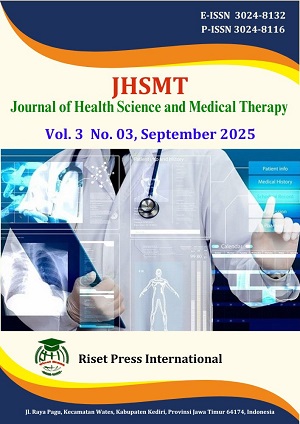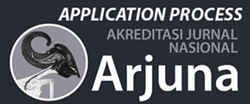Effect of Dental Health Education Media Using Posters on Knowledge of Oral and Dental Care Among Patients
DOI:
https://doi.org/10.59653/jhsmt.v3i03.1882Keywords:
Dental Health Education, Posters, Knowledge, Dental Health Education, Posters, KnowledgeAbstract
Low public awareness regarding oral hygiene can lead to a high prevalence of dental diseases such as caries and periodontal conditions. Health education using appropriate media is expected to improve public knowledge, one of which is through poster media. Objective: To determine the effect of dental health education using poster media on improving patients’ knowledge of oral hygiene at Aceh Jaya Public Health Center. This study employed a quasi-experimental design with a pretest-posttest control group approach. A total of 58 patients were assigned to both the intervention and control groups using purposive sampling. The intervention group received dental health education using posters, while the control group received no intervention. A validated questionnaire on toothbrushing knowledge was used as the assessment tool. Data were analyzed using the Wilcoxon Signed Ranks Test due to non-normal data distribution. There was a statistically significant increase in knowledge in both the intervention group (p = 0.000) and the control group (p = 0.007), with a greater improvement observed in the intervention group. All respondents in the intervention group either showed improvement or maintained their knowledge level, with no decrease observed. Dental health education using poster media is effective in increasing patients’ knowledge of oral hygiene at Aceh Jaya Public Health Center. This method is recommended as part of health promotion strategies in primary healthcare settings.
Downloads
References
al, et, pengetahuan dan, H., Pengetahuan Dan Kebiasaan Menggosok Gigi Dengan Kejadian Karies Gigi Sdi Darul Mu, H. DI, Kota Banjarmasin Tahun, M., Eddy Rahman, dan, & Islam Kalimantan Muhammad Arsyad Al Banjari Banjarmasin, U. (2017). HUBUNGAN PENGETAHUAN DAN KEBIASAAN MENGGOSOK GIGI DENGAN KEJADIAN KARIES GIGI DI SDI DARUL MUâ€TMMININ KOTA BANJARMASIN TAHUN 2017. DINAMIKA KESEHATAN: JURNAL KEBIDANAN DAN KEPERAWATAN, 8(1), 212–218. https://ojs.dinamikakesehatan.unism.ac.id/index.php/dksm/article/view/250
Anneke Tahulending, J. d’Arc Z. A. (2018). (tahulenting aa)HUBUNGAN PENGETAHUAN TENTANG KARIES GIGI DENGAN INDEKS DMF-T IBU-IBU RUMAH TANGGA DI KELURAHAN TERNATE TANJUNG.
elkhodery, osama, eisa, abd elhameed, & abdallah, alaa eldeen. (2020). Effectiveness of Video and Poster Educational Programs in Dental Caries Prevention and Oral Hygiene StatusAmong Primary School Students. Al-Azhar Journal of Dental Science, 23(2), 193–199. https://doi.org/10.21608/AJDSM.2020.29234.1058
Evie Oktaviani, Yusi Sofiyah, E. Lusiani. 2020. (2020). Hubungan_Peran_Orangtua_Dalam_Membimbing anak karies.
Hanif, F., & Prasko, P. (2018). PERBEDAAN PENGARUH PENYULUHAN MENGGUNAKAN MEDIA VIDEO DAN BONEKA TANGAN TERHADAP PENINGKATAN PENGETAHUAN KESEHATAN GIGI DAN MULUT PADA SISWA SEKOLAH DASAR. Jurnal Kesehatan Gigi, 5(2), 1–6. https://doi.org/10.31983/JKG.V5I2.3854
Harahap, R. F., Satari, M. H., & Sukandar, H. (2019). EFEKTIVITAS BOOKLET TERHADAP PENGETAHUAN DAN SIKAP PEMELIHARAAN KESEHATAN GIGI MULUT PADA IBU HAMIL. Jurnal Maternitas Kebidanan, 4(1), 66–74. https://doi.org/10.34012/jumkep.v4i1.499
Laforgia, A., Inchingolo, A. M., Inchingolo, F., Sardano, R., Trilli, I., Di Noia, A., Ferrante, L., Palermo, A., Inchingolo, A. D., & Dipalma, G. (2025). Paediatric dental trauma: insights from epidemiological studies and management recommendations. BMC Oral Health, 25(1), 6. https://doi.org/10.1186/S12903-024-05222-5
Linus, C., & Bassey, C. L. (2025). ASSESSMENT OF GRAPHIC POSTER DESIGN AND ENVIRONMENTAL SUSTAINABILITY IN AKWA IBOM STATE. GASPRO INTERNATIONAL JOURNAL OF EMINENT SCHOLARS, 12, 2659–1057.
Nufus, F., & Reca, R. (2024). Relationship between tooth brushing maintenance actions and OHIS status in schizophrenia patients at Aceh Mental Hospital. Journal of Health Science and Medical Therapy, 2(03 SE-Articles), 240–248. https://doi.org/10.59653/jhsmt.v2i03.1126
Pedwell, R. K., Hardy, J. A., & Rowland, S. L. (2017). Effective visual design and communication practices for research posters: Exemplars based on the theory and practice of multimedia learning and rhetoric. Biochemistry and Molecular Biology Education, 45(3), 249–261. https://doi.org/10.1002/BMB.21034’))
Rahayu, E. S., Salfiyadi, T., & Reca, R. (2024). Effectiveness of Gargling with Lemon Juice (Citrus lemon) and Betel Leaf Decoction on Debris Index and Saliva pH of Elementary School Students in Aceh Besar District. Journal of Health Science and Medical Therapy, 2(03 SE-Articles), 249–258. https://doi.org/10.59653/jhsmt.v2i03.1139
Saidah, A., Isni, K., Studi Kesehatan Masyarakat Fakultas Kesehatan Masyarakat Universitas Ahmad Dahlan, P., & Edukasi Kesehatan Mulut dan Gigi Terhadap Tingkat Pengetahuan Anak di Kelurahan Rejowinangun, P. (2022). Pengaruh Edukasi Kesehatan Mulut dan Gigi Terhadap Tingkat Pengetahuan Anak di Kelurahan Rejowinangun, Yogyakarta: Media Publikasi Promosi Kesehatan Indonesia (MPPKI), 5(2), 205–210. https://doi.org/10.56338/MPPKI.V5I2.2071
Santoso, B., Anwar, M. C., & Muliadi, M. (2019). MONOPOLY GAME AS ANDROID-BASED DENTAL HEALTH EDUCATION MEDIA. Journal of Applied Health Management and Technology, 1(1), 7–15. https://doi.org/10.31983/JAHMT.V1I1.5305
Suryenti Putri, V., Studi, P. S., Baiturrahim Jambi Program Studi, Stik. D., & Baiturrahim Jambi, Stik. (2021). Efektifitas Gosok Gigi Massal dan Pendidikan Kesehatan Gigi Mulut pada Anak Usia 7-11 Tahun di SDN 174 Kel. Murni Kota Jambi. Jurnal Abdimas Kesehatan (JAK), 3(1), 63–71. https://doi.org/10.36565/JAK.V3I1.152
Wong, C. Y., & Cheung, K. Y. (2014). Effectiveness of Educational Poster on Knowledge of Emergency Management of Dental Trauma-Part 2: Cluster Randomised Controlled Trial for Secondary School Students. PLoS ONE, 9(8), 101972. https://doi.org/10.1371/journal.pone.0101972
Downloads
Published
How to Cite
Issue
Section
License
Copyright (c) 2025 Andriani, Azhari

This work is licensed under a Creative Commons Attribution-ShareAlike 4.0 International License.
Authors who publish with this journal agree to the following terms:
- Authors retain copyright and grant the journal right of first publication with the work simultaneously licensed under a Creative Commons Attribution-ShareAlike that allows others to share the work with an acknowledgement of the work's authorship and initial publication in this journal.
- Authors are able to enter into separate, additional contractual arrangements for the non-exclusive distribution of the journal's published version of the work (e.g., post it to an institutional repository or publish it in a book), with an acknowledgement of its initial publication in this journal.
- Authors are permitted and encouraged to post their work online (e.g., in institutional repositories or on their website) prior to and during the submission process, as it can lead to productive exchanges, as well as earlier and greater citation of published work (See The Effect of Open Access).
























